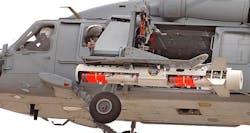Navy ramps-up production of airborne counter-mine systems to neutralize hidden ocean mines
Officials of the Naval Sea Systems Command in Washington are asking the Raytheon Integrated Defense Systems segment in Portsmouth, R.I., to build, test, and deliver low-rate initial production (LRIP) Airborne Mine Neutralization Systems (AMNS) and engineering services and support.
Raytheon is doing the work under terms of an $11 million contract announced Friday. The contract has options that could increase its value to as much as $58.1 million.
The AMNS will provide littoral combat ship (LCS) commanders with a rapid, organic mine neutralization capability against bottom and moored sea mines. Navy forces will deploy the AMNS from the MH-60 helicopter as part of the LCS mine countermeasures mission module, Navy officials say.
Related: Navy orders unmanned combat vehicles for littoral combat ship to find and kill ocean mines
LRIP describes small-quantity weapons production for final testing and evaluation in actual military operations before full-rate production. LRIP typically is the first step in switching from customized, hand-built prototypes to the final mass-produced end product. Raytheon won separate contracts in early 2014 to build six new LRIP AMNS systems.
The AMNS deploys explosive mine-destroying vehicles from a launch and handling system (LHS) on the Navy MH-60S helicopter. The mine-destroying unmanned underwater vehicle (UUV) takes its control from the helicopter's common console; it identifies mines before controllers on the helicopter command it to explode and destroy the mine nearby.
The AN/ASQ-235 AMNS consists of two major subsystems: the LHS and the neutralizer. The LHS performs data processing during an AMNS mission, while the LHS manages the neutralizers, and enables the helicopter's common console to communicate with the neutralizers.
The LHS connects with the carriage stream tow and recovery system (CSTRS) and can carry as many as four neutralizers on each mission. Each of the four neutralizers can launch one at a time without recovering the LHS.
The neutralizer communicates with the common console via a fiber-optic data link and provides sonar and video data to operators using the common console. The neutralizer contains a sonar, video camera, and light to find, identify, and attack enemy sea mines.
The neutralizer has six degrees of motion, can maintain a hover position, and can be operated either in automatic or manual mode. The neutralizer also can monitor depth and relative distance from the bottom and can avoid bottom plowing. The operators determine the neutralizer's position with an Integrated Track Point II acoustic tracking system in the LHS.
On this contract modification Raytheon will do the work in Portsmouth, R.I., and should be finished by May 2016. For more information contact Raytheon Integrated Defense Systems online at www.raytheon.com, or Naval Sea Systems Command at www.navsea.navy.mil.
Learn more: search the Aerospace & Defense Buyer's Guide for companies, new products, press releases, and videos
